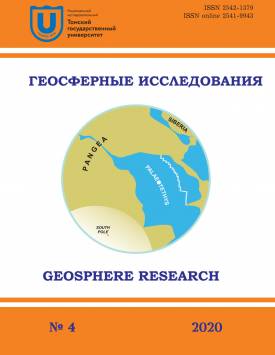Peculiar properties of the snow line depression in the Baikal region during the Sartan stage of the Late Pleistocene Glaciation
On the basis of remote sensing methods by the Partch and Brueckner method, using materials from geological surveys with a scale of 1: 200,000 and research results obtained by scientific organizations, the nature of the snow boundary in the maximum phase of the Sartan glaciation in the territory of the Baikal region was restored. The principal moment of the reconstructions was the determination of the magnitude of the global, regional and local depressions of the snow boundary, due to both climatic factors and the orography of mountain structures, the heights of their watersheds and frontal scarps, as well as the orientation in space and the exposure of slopes. By the absolute marks of destructive and accumulative traces of glacial activity using topographic maps, aerial and satellite images of large and medium scales, depending on the size of the glacial morphology object and the degree of its detailing, the lower boundary of the chionosphere has been established. Its intersection with the terrain outlines the areas of glacier feeding, influencing their size, activity, and contributes to the age and lateral linking of destructive and accumulative glacial formations both in the Baikal region and in the mountainous regions of southern Eastern Siberia. The depression of the orographic snow boundary was established on average by 13001400 m in relation to the modern climatic one. On the southern coast of Lake Baikal (up to 1200 m above sea level) and at the base of the western cliff of the Stanovoy Upland (up to 900 m), its negative extremes are revealed, and on the Patom Upland, Vitim plateau and in the western part of the ridge. Khamar-Daban - positive. As a result of the restoration of the orographic snow boundary of the maximum phase of the Sartan glaciation, areas with a positive balance of solid atmospheric precipitation within the studied area were outlined. Stable snow cover in this area determined the areas of glacier feeding. The largest of them covered watershed areas and slopes of ridges: Baikalsky, Barguzinsky, Verkhneangarsky, Delyun-Uransky, Severo-Muisky, Yuzhno-Muisky, Kalarsky and Kodar ridge. The revealed patterns of deformation of the lower boundary of the chionosphere were determined by global, regional and local climatic features of the Baikal region. All paleogeographic constructions were carried out using the computer programs Google Earth Pro and SAS. Planet. Release. Due to the large area of the considered territories, the final generalization of the primary material was carried out on a topographic basis on a scale of 1: 500,000.
Keywords
Late Pleistocene, cirque, snow line, exaration, moraine, reconstruction, Paleoglaciology, Baikal RegionAuthors
| Name | Organization | |
| Enikeev Farid I. | Institute of Natural Resources, Ecology and Cryology SB RAS |
References

Peculiar properties of the snow line depression in the Baikal region during the Sartan stage of the Late Pleistocene Glaciation | Geosphere Research. 2020. № 4. DOI: 10.17223/25421379/17/3
